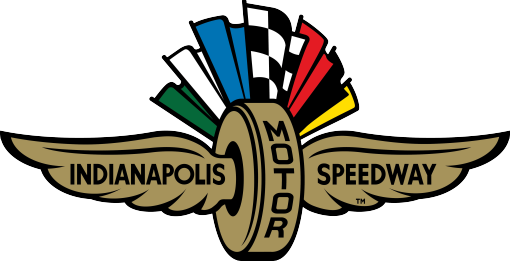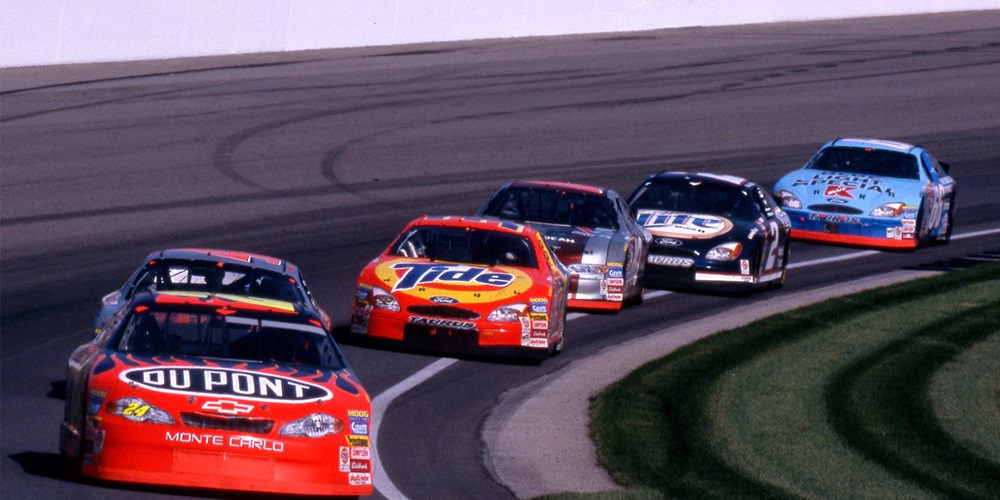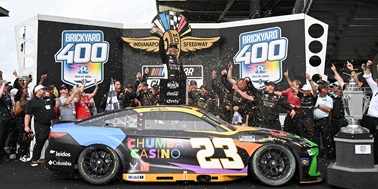2000
The 2000 Brickyard 400 featured 43 cars, but it became clear within the first 40 laps that this event was going to resemble a heavyweight title fight more than a race.
When Rusty Wallace took the lead from Jerry Nadeau on Lap 44, the race’s marquee could have resembled a fight poster reading “Rusty vs. Bobby: The Battle on the Bricks.”
1989 Cup Series champion Wallace and Labonte were the only leaders for the rest of the 160-lap race. And they staged perhaps the greatest extended head-to-head duel in the 24-year history of the race, with Labonte prevailing with the most prestigious victory of his illustrious career.
Wallace was the dominant driver of the day in his No. 2 Miller Lite Ford owned by the legendary Roger Penske, leading 110 of the 160 laps. And when he took the lead from Labonte on Lap 123, it appeared Wallace would deliver the first NASCAR victory at IMS for Penske, the winningest team owner in Indianapolis 500 history.
But Labonte never gave up. Labonte nosed his No. 18 Interstate Batteries Pontiac owned by NFL coaching legend Joe Gibbs ahead of Wallace in Turn 3 on Lap 146. But Wallace didn’t throw in the towel.
Wallace and Labonte raced side by side down the front straightaway, with the right front of Labonte’s car rubbing against the left rear of Wallace’s car as they approached the Yard of Bricks. Labonte led at the line by a scant .004 of a second.
Labonte finally pulled clear of Wallace in Turn 1 on Lap 147 and then poured on the speed, building a gap of 4.229 seconds by the time the checkered flag flew after Lap 160.
2001
The eighth annual Brickyard 400 made history before the green flag even waved to start the race, as it was the first edition of the race to take place on a Sunday. The previous seven races all were contested on Saturdays.
But more memorable history was made three hours, 30 minutes and three seconds after the green flag first waved, as Jeff Gordon became the first three-time winner of the race in his No. 24 DuPont Chevrolet.
Gordon earned his historic victory the hard way, rallying from the 27th starting spot for victory. It’s still the deepest starting position for any winner of this race.
That charge wasn’t a bull rush but instead methodical for Gordon, who didn’t take the lead for the first time until a round of green-flag pit stops on Lap 109. During the sixth of seven caution periods, crew chief Robbie Loomis also helped Gordon’s race toward the front with a gutsy call, changing only two tires.
Gordon gained three spots due to Loomis’ strategic master stroke, starting second on the ensuing restart on Lap 136. Gordon then wasted little time taking the lead for good, diving under Sterling Marlin in Turn 1 on the restart and leading the final 25 laps.
Marlin never relented in his pursuit but ended up .943 of a second short of Gordon at the finish. The victory provided Gordon a springboard toward his fourth Cup title, as he became the fourth consecutive driver to win the Brickyard and the series championship in the same year.
2002
The contrast couldn’t have been starker.
In 2001, “Boy Wonder” Jeff Gordon became the first three-time winner of the Brickyard 400 the day after his 30th birthday. Gordon was one of the polished young stars starting to dominate the sport as it progressed into a new era of mainstream conversation in America.
But fast-forward to 2002, and 46-year-old Bill Elliott stood in Victory Lane at the Brickyard, ringing one up for the “old guys” who helped to elevate NASCAR from a regional sport to a national phenomenon during the 80s and 90s. Elliott still is the oldest winner of this race.
Elliott’s victory wasn’t a complete shock. He won the previous race, at Pocono, in his No. 9 Dodge owned by Ray Evernham, who was the crew chief for Gordon’s first two Brickyard victories before starting his own team. And Elliott had recorded six top-10 finishes in his first eight starts at IMS.
“Awesome Bill” turned back the clock to his dominant days in the mid- to late 80s at this event, leading 93 of 160 laps. Elliott and Evernham paved the way to Victory Lane in a pre-Brickyard test session, during which they ignored the shiny penny of raw qualifying speed and focused on performance over long fuel runs.
That strategy paid off. Elliott hunted down Rusty Wallace on a green-flag run late in the race, using four fresher tires to passing fellow Cup champion Wallace – who took just two tires on his previous stop – for the lead in Turn 3 on Lap 149.
Elliott pulled away and then held off Wallace and the rest of the field on the final restart, with four laps to go, for one of the sweetest victories of his Hall of Fame career.
2003
This race lost one of its all-time fan favorites when 1995 Brickyard winner Dale Earnhardt was fatally injured in a crash in the 2001 Daytona 500. But reminders of The Intimidator were everywhere after Kevin Harvick won this race in 2003.
Harvick replaced Earnhardt at Richard Childress Racing after Earnhardt’s death, and he reminded many fans of The Man in Black. Harvick was brash and aggressive. He drove the famous Goodwrench Chevrolet, now carrying No. 29 and featuring hints of silver and red in its trademark black color scheme.
It’s safe to say Earnhardt would have been proud of Harvick’s performance Aug. 3, 2003. Harvick led 33 laps and became the first driver to win this race from the pole.
Harvick used lap traffic to pass Matt Kenseth for the lead on a restart on Lap 145, and Harvick never surrendered the top spot. But there still was drama in the final 10 laps, as a big accident on Lap 146 that collected six cars in Turn 3 forced a restart with 10 laps remaining.
“Happy Harvick” drove away from the field from the outside lane on the restart, finishing 2.758 seconds ahead of second place Kenseth.
Emotion flowed freely in Victory Lane. It was the first Brickyard win for team owner Richard Childress since Earnhardt’s victory in 1995, and Harvick was overjoyed to win on the track where his childhood racing idol, fellow Bakersfield, California, resident Rick Mears, won four Indianapolis 500s.
2004
After the 2004 edition of the Brickyard 400, the debate ended. There was no question Jeff Gordon was the greatest driver in the 11-year history of the race.
Gordon recorded his unprecedented fourth Brickyard victory in just his 11th start in the race, matching Indianapolis 500 legends A.J. Foyt, Al Unser and Rick Mears as four-time winners of major events on the historic IMS oval.
Former Indiana resident Gordon dominated this race, leading 124 of 161 laps. The only suspense came during the first “green-white-checkered” finish in NASCAR history after the last of 13 caution periods that slowed the average speed to 115.037 mph.
Terry Labonte, Ryan Newman and Brian Vickers were collected in a crash on Lap 156, forcing NASCAR’s version of “overtime.”
Gordon lined up ahead of two-time Brickyard winner Dale Jarrett on the restart on Lap 160. Jarrett never got close to Gordon over the final two laps. The race ended under caution, with Gordon firmly in control, after Ricky Rudd hit the wall and Mark Martin and Dale Earnhardt Jr. suffered cut tires on the last lap.
There was almost no one in the same orbit as Gordon all day in the race. Elliott Sadler was the only other driver to lead more than two laps, taking the top spot for 32 laps overall.
This was Gordon’s day of dominance, the date in which he stamped his name forever on the Brickyard.
2005
Tony Stewart grew up in Columbus, Indiana, just 50 miles from the Indianapolis Motor Speedway. He would race home from school as a boy and listen to and watch coverage of Indianapolis 500 practice and qualifying or jump into a truck with his family and head to the Speedway to watch.
Stewart was a prodigy behind the wheel of a race car, winning the USAC Triple Crown in 1995, the NTT INDYCAR SERIES championship in 1996-97 and many Cup Series races after starting his full-time Cup career in 1999 with Joe Gibbs Racing.
But there was one missing entry on his resume – a win at Indianapolis, his Field of Dreams. It was the place he wanted to win more than anywhere else.
Stewart had plenty of close calls. He led in four of his five Indianapolis 500 starts for a total of 122 laps. But his best “500” finish was fifth in 1997.
Entering the Brickyard in 2005, Stewart had finished no better than fifth in his prior six NASCAR starts at IMS. His patience was wearing thin with questions from media and fans about when he would finally win at his beloved track.
Those questions ended with one of the most joyous, memorable victories in the history of this race. Stewart led a race-high 44 laps, but he needed to hold off fellow USAC graduate Kasey Kahne over the final 11 laps, winning by 0.794 of a second as the huge crowd roared and pumped their arms in celebration.
Few who saw the race on television could forget Stewart’s father, Nelson Stewart, hanging over the railing in the Turn 2 Suites and pointing his index finger at his temple, encouraging his mercurial son to keep a cool head in the final charge to the Yard of Bricks.
And no one forgot the post-race scene, when Stewart stopped his No. 20 Home Depot Chevrolet in front of the Turn 2 suites, took a swig from a can of Coca-Cola from a fan and saluted his friends and family. Then, Stewart drove back to the Yard of Bricks and climbed the front stretch fence in celebration with his Joe Gibbs Racing crew.
“I wish I could put it into words,” Stewart said as he laid on the outside wall on the front stretch after climbing the catch fence. “Today’s been my entire life.”
2006
A new era started for the Brickyard 400 with this race. Call it the JJ Era or the Reign of 48.
Jimmie Johnson earned the first of his four Brickyard 400 victories – which came in the span of seven years – with an unlikely triumph in the No. 48 Lowe’s Chevrolet fielded by Hendrick Motorsports.
Indy had been a bogey track for Johnson in his first four starts, with finishes of ninth (2002), 18th (2003), 36th (2004) and 38th (2005). It appeared early in the 2006 race that this trend of disappointment would continue, as Johnson suffered a cut left front tire that eventually broke apart and damaged the sheet metal of his left front fender.
Johnson didn’t lose a lap as the Hendrick Motorsports team led by crew chief Chad Knaus calmly and quickly replaced the tire and did a quick patch job on the fender damage so Johnson wouldn’t lose the slippery aerodynamics needed to find speed on the long front and back straightaways at IMS.
Still, Johnson was mired in 38th place after the blown tire. But aggressive driving helped Johnson climb back toward the leaders, and he took the top spot for the first time on Lap 117 of 160.
Johnson passed Dale Earnhardt Jr. on Lap 151 for the lead and never trailed thereafter, winning under caution due to a hard last-lap crash in Turn 3 by Kasey Kahne. Johnson became just the second driver to win the Daytona 500 and at the Brickyard in the same season, joining Dale Jarrett in 1996.
2007
After five starts in the Indianapolis 500 and six starts in the Big Machine Vodka 400 at the Brickyard Powered by Florida Georgia Line, Tony Stewart finally broke through with his first victory at his beloved Indianapolis Motor Speedway in 2005.
It only took him two more starts to visit Victory Lane again.
Stewart dominated the 2007 event, leading a race-high 65 out of 160 laps and beating Indianapolis 500 winner Juan Pablo Montoya to the Yard of Bricks by 2.982 seconds at the finish.
Indiana native Stewart started 14th, but it became apparent early that his No. 20 Home Depot Chevrolet was a rocket ship. He first led on Lap 17, leading five more times until a restart on Lap 141.
The handling of Stewart’s car tightened as he drove into Turn 1 on the restart, and good friend and rival Kevin Harvick drove past for the lead. But Stewart’s car loosened after a few laps, and he knew he had a car fast enough to pass Harvick with patience.
So then Stewart, with typical swagger, uttered his famous line, “Here, kitty, kitty, kitty; come get you some of this,” on the team radio as he chased down Harvick with ease. He passed Harvick for first on Lap 151 and then drove away for the decisive victory.
2008
Jimmie Johnson showed a different type of mental strength to earn his second Brickyard victory in the most surreal, bizarre edition of the race in history.
During his first victory, in 2006, Johnson and the Hendrick Motorsports team overcame a flat tire that caused fender damage early in the race to rally from 38th place to victory. This year, Johnson and the rest of the field endured excessive tire wear that forced NASCAR to throw yellow flags about every 10 laps for safety reasons so teams could change tires.
These “competition cautions” converted the race into a series of 10-lap sprints, and Johnson led a race-high 71 of 160 laps, using fast work by the Hendrick crew on pit stops and strong restarts after the caution periods to gain track position.
The final “competition caution” came on Lap 151 with Denny Hamlin leading. The field headed to the pits for a final tire change, and Johnson won the race off pit road with a slick six-second stop.
Johnson pulled away from Carl Edwards on the restart, but Edwards never relented. Johnson held off Edwards by .332 of a second at the finish to become just the fourth driver to win this event at least twice, joining Jeff Gordon, Dale Jarrett and Tony Stewart. Hendrick Motorsports also earned its record sixth victory at the Brickyard.
2009
There were no tire problems. There was Jimmie Johnson becoming the first repeat winner in the race’s history. But perhaps the biggest memory from the 2009 Brickyard 400 was the one that got away from Juan Pablo Montoya.
Johnson earned his third overall Brickyard win since 2006 and became the first back-to-back winner in this event’s history by leading 24 laps in the No. 48 Lowe’s Chevrolet. But every driver on the track – including Johnson – and the crowd knew Montoya lost a golden chance to become the first driver to win the Indianapolis 500 and the Brickyard 400.
Montoya dominated the early stages of the race in his No. 42 Target Chevrolet fielded by Chip Ganassi Racing, as he continued to show the skill at IMS that helped him win the 2000 Indianapolis 500 as a rookie and finish second to Tony Stewart in his first Brickyard start in 2007.
1999 CART champion Montoya led 116 of the first 124 laps and was on cruise control to victory, building a gap of five seconds over the field. He entered the pits for his last stop with 35 laps remaining and was caught speeding while crossing two timing loops on pit road.
Montoya protested on his radio with the famous “I swear on my children and my wife that I was not speeding. No way!”
That miscue and subsequent drive-through penalty dropped Montoya to 11th at the finish. Meanwhile, Johnson drove to the front for good on Lap 137 and held off charging 50-year-old Mark Martin – who the day before became the oldest pole sitter ever at IMS – by .400 of a second at the finish.




